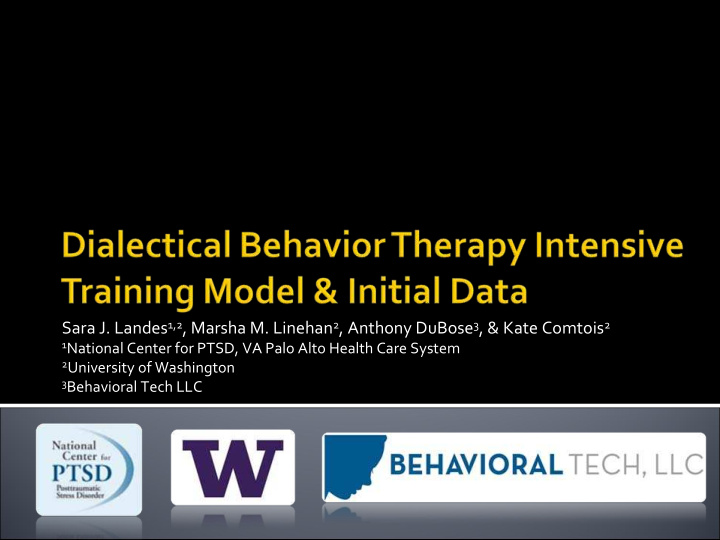



Sara J. Landes 1,2 , Marsha M. Linehan 2 , Anthony DuBose 3 , & Kate Comtois 2 1 National Center for PTSD, VA Palo Alto Health Care System 2 University of Washington 3 Behavioral Tech LLC
• Suicidal behavior • Non ‐ suicidal self ‐ injury • Depression • Hopelessness • Anger • Symptoms of eating disorders • Substance dependence • Impulsiveness • General adjustment • Social adjustment • Treatment retention • Positive self esteem
1. Administrator Training Functional Systemic Support Mechanisms Study Group Implement Read Manual / Online Training (Organize Teams) Program Homework / Exercises / Take-Home Exam/ System Outcome data collection Part I Part III Orientation Online Learning Courses Introductory Workshop Part II 5-Day Treatment 5-Day Consultation on + Content and Structure Program Implementation / Consultation with Experiential Learning Institutional Leadership 3-day Skills training Consultation (Program Development) Ongoing / Supplemental Training and Consultation as Needed Adherence to Treatment Protocols (Clinical Cases)
Create a team first and go through the manual together Add modes gradually Skills training, individual, phone calls Adapt to setting e.g., no phone calls for coaching in a prison setting, floor coaching in residential settings Start small and build
Participants showed a significant increase in DBT knowledge between all time points Part I to Mid ‐ Intensive ( t (38) = 5.81, p <.001) Mid ‐ Intensive to Part II ( t (49) = 2.43, p <.02) Part I to Part II ( t (39) = 6.99, p <.001)
Standard DBT Treatment Modes Offered at End of Part II, 2000 Offered in Oct, 2001 DBT Group Skills Training 11 (78.6%) 12 (85.7%) DBT Individual Psychotherapy 7 (50.0%) 10 (71.4%) DBT Therapist Consultation Team 10 (71.4%) 10 (71.4%) Telephone Consultation 4 (28.6%) 6 (42.9%) Complete DBT Model without Telephone Consultation 7 (50.0%) 10 (71.4%) Complete DBT Model with Telephone Consultation 4 (28.6%) 6 (42.9%) Optional DBT Treatment Modes Offered at End of Part II, 2000 Offered in Oct, 2001 DBT Individual Skills Training 6 (42.9%) 7 (50.0%) DBT Pharmacotherapy 4 (28.6%) 4 (28.6%) DBT Case Management 3 (21.4%) 3 (21.4%) DBT Support/Process Group Psychotherapy 4 (28.6%) 5 (35.7%) None 1 (7.1%) 1 (7.1%)
Program adherence measure has been piloted and will be used for program accreditation Because of the complexity of the in ‐ session adherence measure, it’s been limited to research Haven’t yet found a way to do assess in ‐ session adherence that’s easily disseminable
Review of 25 studies of DBT in the community, primarily trained with intensive training showed improvements in various client outcomes Outcome data from Part II Average number of self ‐ inflicted injurious acts ▪ 1 st month of treatment = 3.67 ▪ Current month of treatment = 0.83 ▪ t (5)= ‐ 1.63, 1 ‐ tailed p ‐ value=0.08, d =0.66
In development at the University of Washington Computed Global Score of DBT adherence and sub ‐ scale scores for 12 strategy domains Composed of 66 items reflective of major DBT strategies, each operationalized with behaviorally defined anchor points Conditions for scoring take into account the necessity and sufficiency of each strategy given the context of the session and prescriptions and proscriptions of the DBT treatment manual Inter ‐ rater reliabilities of mean scores in previous samples of strategy items range from .78 to .83, with correlations between the mean score of items and the Global Rating ranging from .89 to .99
Recommend
More recommend